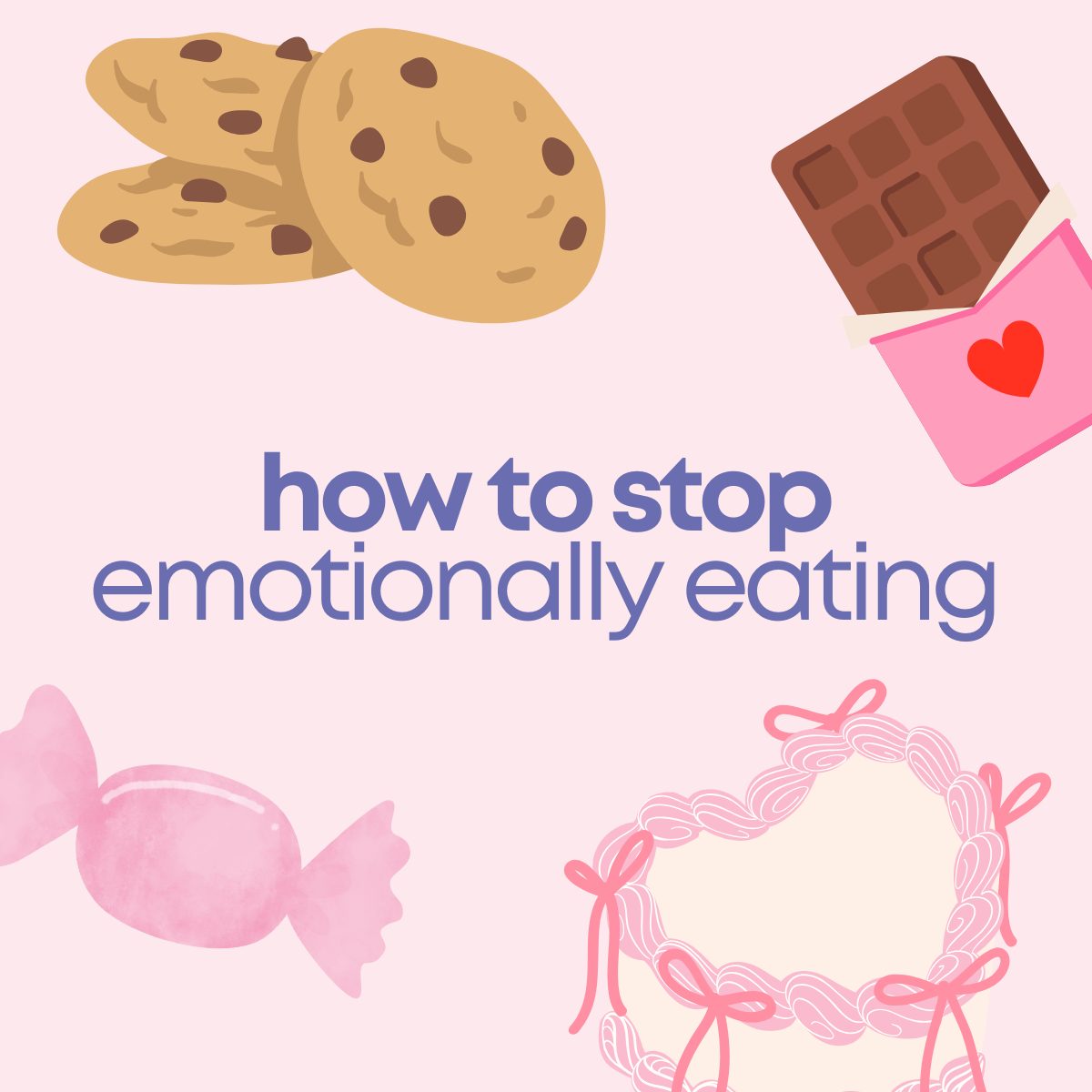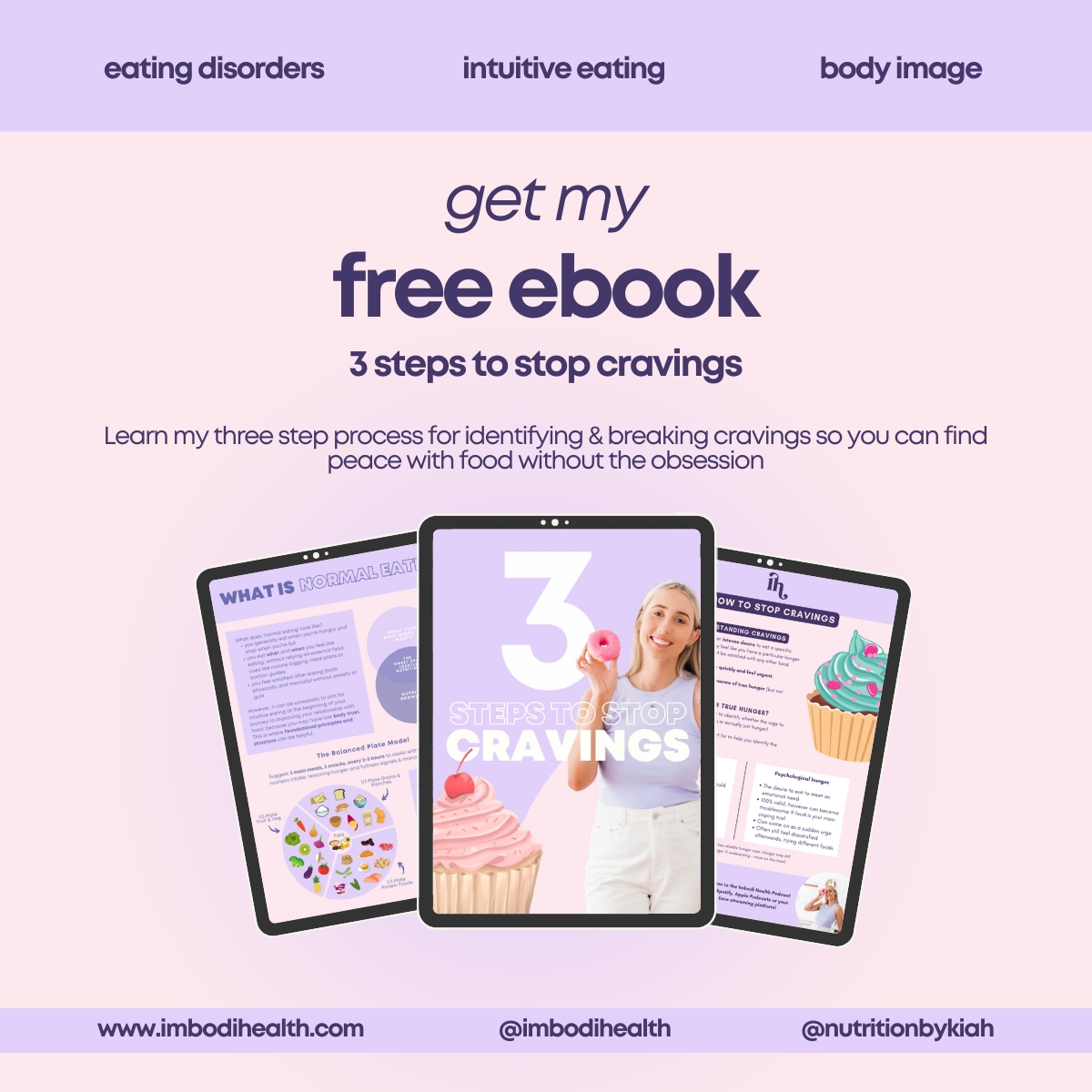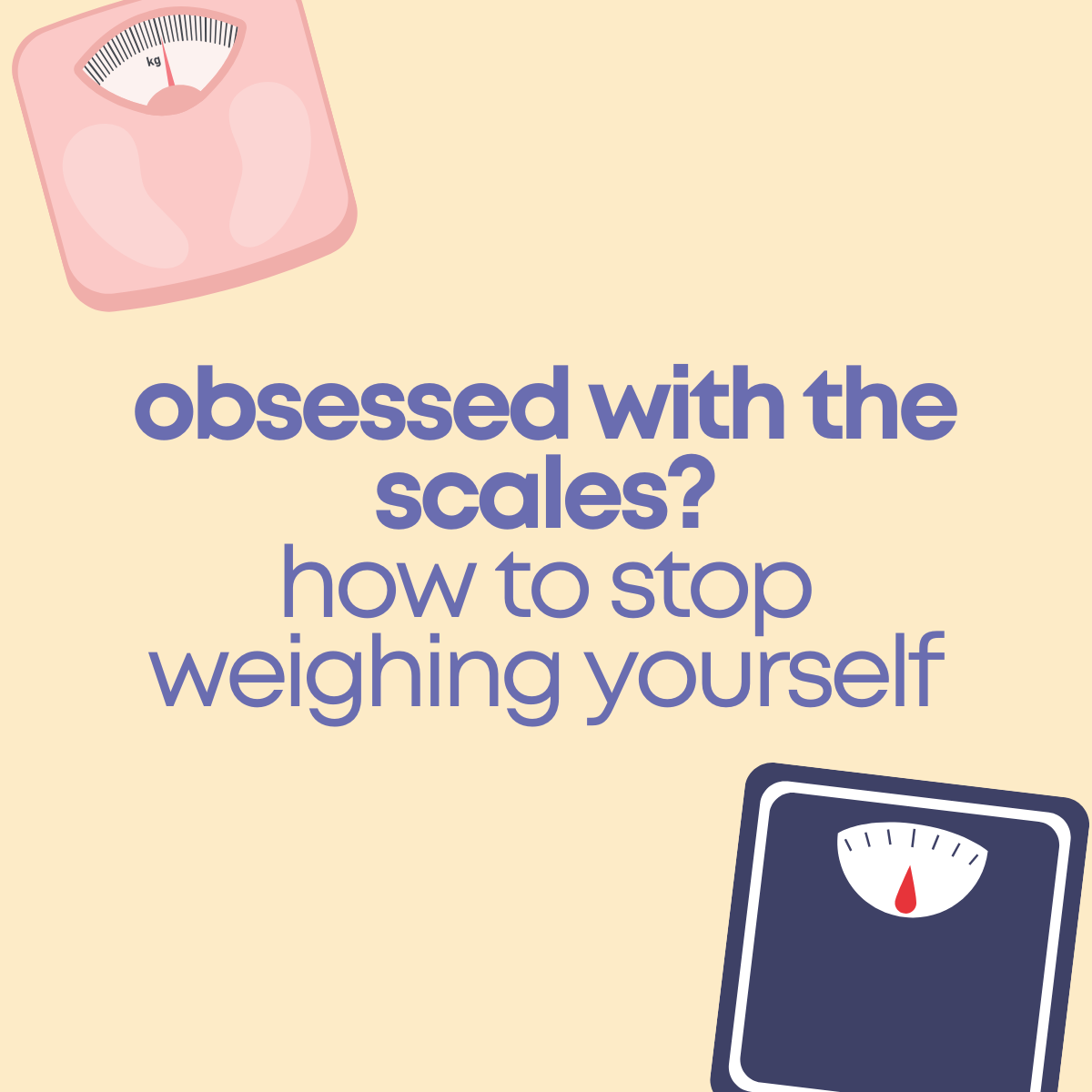Welcome back to another episode of the Imbodi Health Podcast. Today we’re going to be chatting all things emotional eating, but before we get into that, let’s kick off with our rants and raves!
Rants and Raves
Meg’s Raves:
A rave is that on the weekend, I went to a swim-up pool bar. You’re in your bikini or togs, and you just hang out, drink cocktails, and swim up to the bar to order. I saw it on TikTok and just thought I had to go!
Meg’s Rant:
A rant is that I’ve seen a lot of “What I eat in a day” posts with body checks lately. It grinds my gears because it promotes a certain body type, implying, “Eat what I eat, and you’ll look like me,” even if it’s not explicitly stated.
Kiah’s Rave:
It’s been so hot, and I’m over sweating all the time. I definitely think pregnancy makes you hotter than usual. We’ve had a heatwave here in Brisbane. As Meg and the other girls on our team know, my aircon at home is broken, so we literally have no aircon. We have a small portable aircon which helps a bit, but it’s still so hot.
On the positive side, we do have a pool where I’m living, which has been so nice. Skyler, my daughter, is really enjoying it, although she’s more confident with jumping in than her swimming ability. So it can be a bit scary at times, but it’s nice to end the day with a little swim.
So, that’s my rave. At least we have something to keep us cool.
Kiah’s Rant:
I had someone I know who struggles a bit with their body image and relationship with food tell me the other day that when they were wedding dress shopping, as part of the celebration for buying their wedding dress, they were given a tape measure.
Like, “Congrats on your wedding day. Here’s a tape measure.”
I talked to a lot of other people about this after hearing that story, and it seems like it’s not a common theme. But it’s horrendous, giving someone a tape measure to measure their waistline just reinforces checking behaviour and implies they need to keep their weight and shape a certain way.
I understand in the wedding industry, you have to sign things saying you won’t change your body weight. If you get a dress tailored and your body changes, the dress might not fit, but there are always ways around that. Giving someone a tape measure just reinforces that checking behaviour. It’s messed up, and that made me really angry.
But let’s have a chat about emotional eating!
Don’t forget to get your hands on my free 3 Steps to Stop Cravings eBook here!
What is Emotional Eating?
Meg: Emotional eating, I guess it sounds pretty straightforward in the name; it’s eating in response to emotions. But it’s not always that simple.
Sometimes a person may not realise that’s what’s going on. So, it might not be a really conscious thing. But sometimes food could come in as a way to meet your needs, even though it probably isn’t meeting needs.
It could satisfy feelings of loneliness or sadness. We know food creates feel-good neurotransmitters, so we get a temporary rush of good feelings. So, it can be quite soothing.
Kiah: It provides us that self-soothing mechanism and avoids sometimes feeling those emotions as well. Like we’ve talked about previously with disordered eating, when our relationship with food is not great, we don’t necessarily want you to get angry at yourself if this is something you struggle with.
There’s always a reason these things happen. Disordered eating functions as a coping mechanism, especially when life is chaotic or stressful, and we can’t get help elsewhere. So, we want to be compassionate to ourselves and recognize that it’s helping us get through a challenging time, even if it’s not making us feel great.
Meg: I’ve been chatting with clients lately about trying to take a curious rather than a self-critical approach to these things. Asking yourself, “Why is this going on for me?” instead of “Oh my God, I can’t believe I’m doing this. Why can’t I stop?”
Those two ways of approaching it are very different. We don’t want to create change through guilting or shaming ourselves. That’s not a nice way to do it.
Kiah: Building that awareness allows us to notice patterns, like recognising when this happens or during specific times of the day.
Then, we can work on those underlying feelings or emotions, rather than just saying, “I’m not going to emotionally eat anymore,” which is a band-aid effect and doesn’t work long-term.
Reasons Why We Emotionally Eat
There are various reasons why we emotionally eat. These may include:
- Feelings like sadness or loneliness
- Feelings of happiness, celebration, and joy.
- Sometimes, this is cultural. From childhood, we learn to eat as a way to celebrate, which can be fantastic. But if it’s the only way we celebrate, then we don’t have other tools in the toolbox.
- Temporary relief from difficult emotions.
- Black and white thinking around food and diet
- Dopamine-seeking behaviours, particularly in people with ADHD
- Negative self-talk
- Experiencing high stress
Emotional Eating: Does It Affect Men As Well As Women?
Meg: The research says it affects both men and women equally.
There may be a perception that it affects women more because women are perceived as being more emotional. But this isn’t the case when we look at the research.
Kiah: Potentially, more women are open to speaking about it compared to men. We know that eating disorders can affect men. We had Alex on our podcast back in season two, who talked all about this.
But unfortunately, it’s not spoken about enough. Men are probably more likely to suffer alone with these issues.
Meg: I’ve had plenty of male clients who’ve come to me to talk about emotional eating. They might prefer to call it “stress eating” or something else because they find it hard to talk about their emotions and label it as such. That’s a different story for a different day—cultural conditioning. But it does affect all genders.
View this post on Instagram
How Can You Tell The Difference Between Emotional Eating And Hunger?
Meg: I would say firstly, we need to be eating regularly. Like we talk about every single episode, this point isn’t going anywhere, guys. If you haven’t gotten the point about regular eating yet, this one’s here to stay.
We want to avoid those big cravings created by not eating regularly enough. If there’s regular eating happening and you have reliable hunger and fullness cues, then you can use something like the hunger and fullness scale.
Long story short, the scale I like to use ranges from 1 to 8: 1 being extremely starving, and 8 feeling so full you’re stuffed and feeling really sick.
You definitely want to start eating around maybe a 3 where you’re beginning to feel hungry—perhaps your concentration is dropping a bit or you’re becoming irritable—but before you’re absolutely starving.
Generally, you want to finish eating around a 6: comfortably full, but not painfully so and not lethargic. Considering whether you’re eating in line with hunger and fullness can give you clues about whether there’s emotional eating or non-hungry eating happening.
Kiah: Another good method is using the acronym “HALT.” So, HALT stands for Hungry, Angry, Lonely, or Tired. Asking yourself, “Am I hungry, angry, lonely, or tired?” can help identify any triggers. Sometimes all you might need is a nap or to go to bed.
There’s no single one-size-fits-all approach. Another clue is noticing if there’s a sense of urgency driving the eating. If there’s a strong craving for a specific type of food, like when an apple just won’t do and you really want chocolate, that could be a sign of emotional eating.
Meg: Oftentimes, even if you eat the chocolate, you might still feel unsatisfied. That mental hunger might drive you to seek out different foods.
You might move from chocolate, to chips, to ice cream – and still feel unsatisfied because essentially, it’s not meeting the need you’re hoping it will, whether you’re conscious of it or not.
Kiah: Another thing to consider is if we’re eating too quickly or mindlessly eating, meaning we’re not really present while eating.
Life is so busy that it can be difficult to slow down and focus on our hunger and fullness cues. Reducing distractions might help, but if you find you’re still eating quickly or mindlessly, that can be a sign of emotional eating.
Meg: Absolutely. Another thing that can come up is a feeling of guilt afterward. We never want to feel guilty after eating.
Sometimes, the guilt arises because deep down, you might know there’s an unmet need, even if you haven’t figured out what it is. You may recognise that food isn’t the coping skill you need, but without identifying the issue, it can be hard to know what to replace food with.
Kiah: We never want to demonise emotional eating. Like we said at the start, it helps us cope at that moment. But for instance, using chocolate to manage stress in the afternoon—while it might offer temporary relief, it won’t solve the underlying problem.
So as much as you might enjoy chocolate, it’s essential to do the mental work to understand why you’re feeling that way and why you’re turning to food in that manner.
How Can You Cope With Emotions Without Using Food?
Disclaimer: if this is something you really struggle with, speaking to a psychologist is always a great idea, especially one trained in the area of disordered eating, body image concerns, or emotional eating.
Meg: Step one is identifying the emotions. This can be quite tricky. One of the most helpful things you can do is just Google a ‘feelings wheel’ and start there. It’s a big wheel that categorises basic feelings like sadness and anger into more nuanced terms. This helps you pinpoint more specifically what you’re feeling.
Kiah: You can pair that with using a food and emotions diary.
You might not want to track the food, but just the emotions. We often use food and emotion diaries with clients. This involves noting the time you ate, what you ate, and perhaps a note if you feel you overate.
Also, adding columns for your thoughts, feelings, and emotions around food and your mood during the meal can help you reflect.
This reflection can be enlightening, like realising you go for chocolates at 3pm when stressed. As Meg said earlier, we aim for a non-judgmental approach. It’s about understanding what’s happening without self-criticism.
Meg: Another helpful strategy is talking to a support person you feel safe with. Discussing what’s going on can assist in identifying your emotions. It’s like having a sounding board.
Kiah:
Once you’ve identified the emotion, the next step is creating an emotion plan.
Consider other coping strategies you could employ in the future. Focus on one emotion at a time.
For instance:
- For sadness, you might try taking a hot bath, journaling, talking to a supportive person, watching a feel-good movie, or listening to music.
- If you’re feeling lonely, reaching out to a loved one or a supportive person can help.
- If you feel you lack a strong support network, joining a community group related to an interest of yours or volunteering can be a wonderful way to connect with people.
- If you’re feeling stressed, doing some exercise. Exercise doesn’t necessarily mean going to the gym; it could be a gentle walk, stretching, or yoga.
- If you’re feeling overwhelmed, try deep breathing exercises like paced breathing—five seconds in, five seconds out—can also be beneficial. There are various versions of these exercises, so finding what works for you is key. Meditation is another effective strategy. Several apps are available, like Smiling Mind, Headspace, and Calm. Smiling Mind is free, whereas Headspace is good but costs $20 a month. Listening to calming music can also be helpful.
Other strategies that can be helpful to manage difficult emotions:
- Set aside time each week for self-care. It could be as simple as exercising or ensuring you get enough sleep. See what adjustments you can make to your routine to accommodate this.
- Talk to the people around you. Sometimes, they may not realise you’re stressed. Having a conversation with your partner or boss about your stress levels and possibly making a plan can be helpful. For instance, if you usually handle all the housework, you could ask your partner to cook dinner to ease your load.
View this post on Instagram
The Delay, Distract, Disarm Method
Meg: This is a method to try and create some space between the desire to eat for emotional reasons.
If you notice that you’re not hungry but wanting to eat and you think it might be linked to emotions, try delaying eating for about 20 minutes.
During this time, distract yourself or use another coping strategy to address the emotion, such as journaling or trying out any of the strategies we’ve discussed.
The “disarm” part involves adjusting our food environment to support your goals. If your aim is to reduce emotional eating, having a big box of chocolates on your desk probably isn’t helpful if you find yourself stress-eating them every day at 2 pm. Consider having access to nourishing foods or adjusting the location of tempting treats to make them less accessible.
Kiah: One tip we often share with clients is creating a snack box, a versatile strategy that can be applied in various contexts. If you’re trying to modify your environment, having a snack box—either in your fridge or on your desk—with a variety of nutritious snacks can be beneficial. This way, when you’re craving snacks or want to work on consistent eating habits due to stress, you can choose from nourishing options.
Meg: Some items that could go in the snack box include popcorn, yogurt, hummus with crackers, and fruit. Other options could be black beans, chickpeas, or even tuna. The key is to choose snacks you genuinely enjoy.
And remember, if you love chocolate, it’s okay to include it. It’s essential to choose snacks that bring you joy and satisfaction.
Mindful Eating
Kiah: Mindful eating is another important aspect to incorporate into your lifestyle. This practice involves engaging all your senses during the eating process, making you more present with your meal. Start by reducing distractions while eating, like avoiding phones or TVs, to better identify hunger and fullness cues.
Meg: Pairing this with slowing down the eating process can also be helpful. Pay attention to chewing your food well and consider putting down your cutlery between bites to prevent eating too quickly.
Kiah: It’s important to engage all your senses during the eating process. Notice how the food sounds, looks, smells, and tastes to fully enjoy and appreciate your meal.
Meg: You’ll likely find that you enjoy and derive more satisfaction from the meal. This is an integral part of the whole Intuitive Eating concept.
Even if you choose to eat for emotional reasons, such as having chocolate, you might feel more fulfilled and satisfied with it, deriving as much enjoyment as possible.
Summary
If we think about when it’s okay to emotionally eat, it’s fine if it’s a conscious decision.
If you feel like you really need that chocolate or snack, try to practice self-compassion. Acknowledge that it’s okay to have these moments without guilt. Emotional eating is a normal human response, but it becomes a concern when it negatively impacts your daily life, causing excessive guilt, pain, or strong emotions. That’s when it’s essential to develop multiple coping strategies.
To summarise the main points we discussed today: We started by defining emotional eating, explored the reasons behind it—such as seeking dopamine, negative self-talk, and stress—and discussed how it affects all genders equally.
We then talked about distinguishing between emotional eating and genuine hunger, suggesting the use of the H.A.L.T acronym (Hungry, Angry, Lonely, Tired) and the hunger and fullness scale.
We also discussed coping with emotions without using food, including strategies for identifying emotions using feelings wheels and journaling. We introduced the Delay, Distract, and Disarm method, provided tips for mindful eating, and wrapped up by emphasizing that it’s okay to emotionally eat—you’re not a robot.
Thanks again for listening to another episode of The Imbodi Health Podcast. If you enjoyed this episode, please leave us a rating and review. We read and appreciate each one.
Follow us on social media at @imbodihealth on Instagram and TikTok, and we look forward to seeing you in our next episode!




Comments +